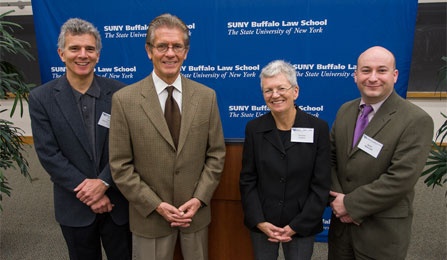Finding the middle ground

Steven R. Sugarman '85, with Chief U.S. District Judge William M. Skretny, Clinical Professor Suzanne E. Tomkins '92, and attorney Scott Bylewski '98 at the Law School's 12th annual Representation in Mediation Competition
Mediation Clinic teaches the real-world skills that get cases settled.
When Steven Sugarman '85 talks about the advantages of mediation – for clients and for the legal system – he speaks with the zeal of an evangelist. Sugarman, who practices with the Kenmore, N.Y., law firm Pusatier, Sherman, Abbott & Sugarman, concentrates his practice on mediation, mostly in divorce and separation cases. He also directs the Law School's Mediation Clinic, which trains students in the skills of this burgeoning area of legal practice – both skills as a mediator and as an attorney advocating for clients at the mediation table.
"This is about listening – about how parties in a dispute need to feel heard and understood by the mediator and by each other before they can effectively problem-solve," Sugarman says about the process, in which a neutral third party, knowledgeable in the law, catalyzes a problem-solving discussion between disputants outside the normal court structure. "It's really a facilitated negotiation. The idea is empowerment. Instead of a judge or arbitrator resolving the dispute, the parties are often best equipped to arrive at a solution that best satisfies their interests. With a mediator's help, parties are encouraged to step away from their stated positions and examine the underlying interests driving those positions. The mediator then motivates parties to think creatively about solutions that satisfy those interests, and legal disputes are resolved saving people money, time and aggravation, as well as minimizing harm to their parenting, business or other relationships."
The Law School's Mediation Clinic builds on Sugarman's courses on the theory and practice of the mediator's art. Six carefully selected students per semester observe mediation sessions and other appropriate dispute resolution processes; learn the practice through role playing, videos and reading; journal about their experiences; and, when it all comes together, serve as mediators for small claims courts in Amherst and Buffalo as well as assisting in mediations in child visitation cases in Family and Supreme courts.
"They're helping real people in real cases resolve disputes, and at the same time honing their negotiation and legal problem-solving skills sets that haven't been utilized much as law students, and finding, hey, this really works," Sugarman says. "They're learning about effective listening, effective facilitation, getting people to engage in more effective negotiations and to even creatively problem-solve."
Besides the skills of mediating a dispute, the clinic helps students learn how to advocate for clients who want to enter the mediation process with a lawyer in tow. Part of that skill, Sugarman says, is managing the expectations of clients who, having watched too many episodes of The Practice, expect their lawyer to be confrontational and adversarial. Students learn that this behavior, at the mediation table, may be contrary to serving their client's best interests.
Mediation Clinic students, along with others interested in mediation, also participate in an intramural mediation competition that tests the effectiveness of lawyer-client pairs, using scenarios and scoring rubrics provided by the American Bar Association. About 30 attorneys from the local Bar serve as mediators and scoring judges for the November competition. The Law School sends the top two teams to the ABA Dispute Resolution Section's Regional Representation in Mediation Competition.
Contact Us
For more information about our Clinical Legal Education programs, please contact:
- Bernadette Gargano, Director of Clinical Legal Education; Vice Dean for Experiential Education and Social Justice Initiatives
- Jordyn Wysocki, Assistant Managing Director of Clinical Legal Education
- Julie Schuster, Senior Program Coordinator; Paralegal
- Audrey Grout, Program Coordinator
Clinical Legal Education Program
University at Buffalo School of Law
507 O'Brian Hall, North Campus
Buffalo, NY 14260-1100
716-645-2167, law-clinic@buffalo.edu